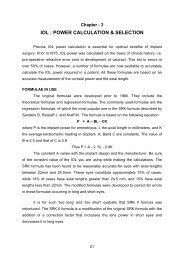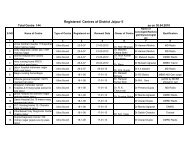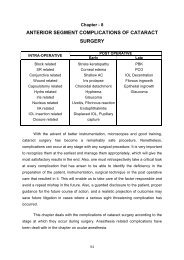THE LENS - APPLIED ANATOMY AND EMBRYOLOGY
THE LENS - APPLIED ANATOMY AND EMBRYOLOGY
THE LENS - APPLIED ANATOMY AND EMBRYOLOGY
You also want an ePaper? Increase the reach of your titles
YUMPU automatically turns print PDFs into web optimized ePapers that Google loves.
Changes in lens shape<br />
The lens undergoes several changes in shape during its embryogenesis.<br />
Initially, it is elongated in the anteroposterior direction. However, at the 18-24 mm<br />
stage, it is approximately spherical and, with the appearance of secondary lens<br />
fibres at the 26mm stage, the lens becomes wider in its equatorial diameter. The<br />
lens then increases rapidly in mass and volume as new fiberes are laid down and<br />
expands in both the sagittal and equatorial planes. At birth the lens is almost<br />
spheroidal, being slightly wider in the equatorial plane. The factors that govern these<br />
changes are unknown but they may be related in part to other factors such as the<br />
steady, but small, dehydration of the entire lens that begins in utero and continues<br />
postnatally.<br />
Applied anatomy<br />
Surgically, the lens is divided into four zones which have different<br />
characteristics and hence merit different attention. These are the capsular bag, the<br />
superficial cortex, the epinucleus, and the hard<br />
nucleus. The capsule has been described in detail<br />
above. The cortex is a soft thin layer present<br />
immediately beneath the capsule. It envelopes the<br />
epinucleus. It is aspirated or irrigated out of the<br />
capsular bag with ease. The epinucleus is a layer of<br />
semi-soft lens matter around the nucleus. This layer<br />
is difficult to aspirate and requires a large bore<br />
cannula for aspiration. It can be managed better by<br />
hydro- or visco-expression. The nucleus is a hard<br />
kernel forming the innermost layer of the lens. The<br />
cataractous lens can be minified down to the nucleus before extraction. This results<br />
in a smaller wound requirement for its exit as the nucleus is usually smaller than the<br />
lenticular opacity. The nucleus can be fragmented before its removal from the eye.<br />
Pre-operative nucleus grading gives us valuable input towards the surgical plan.<br />
7<br />
Surgical anatomy of the lens<br />
A - Anterior chamber; D - Capsule;<br />
C - Cortex ; E - Epinucleus;<br />
N-Nucleus
















